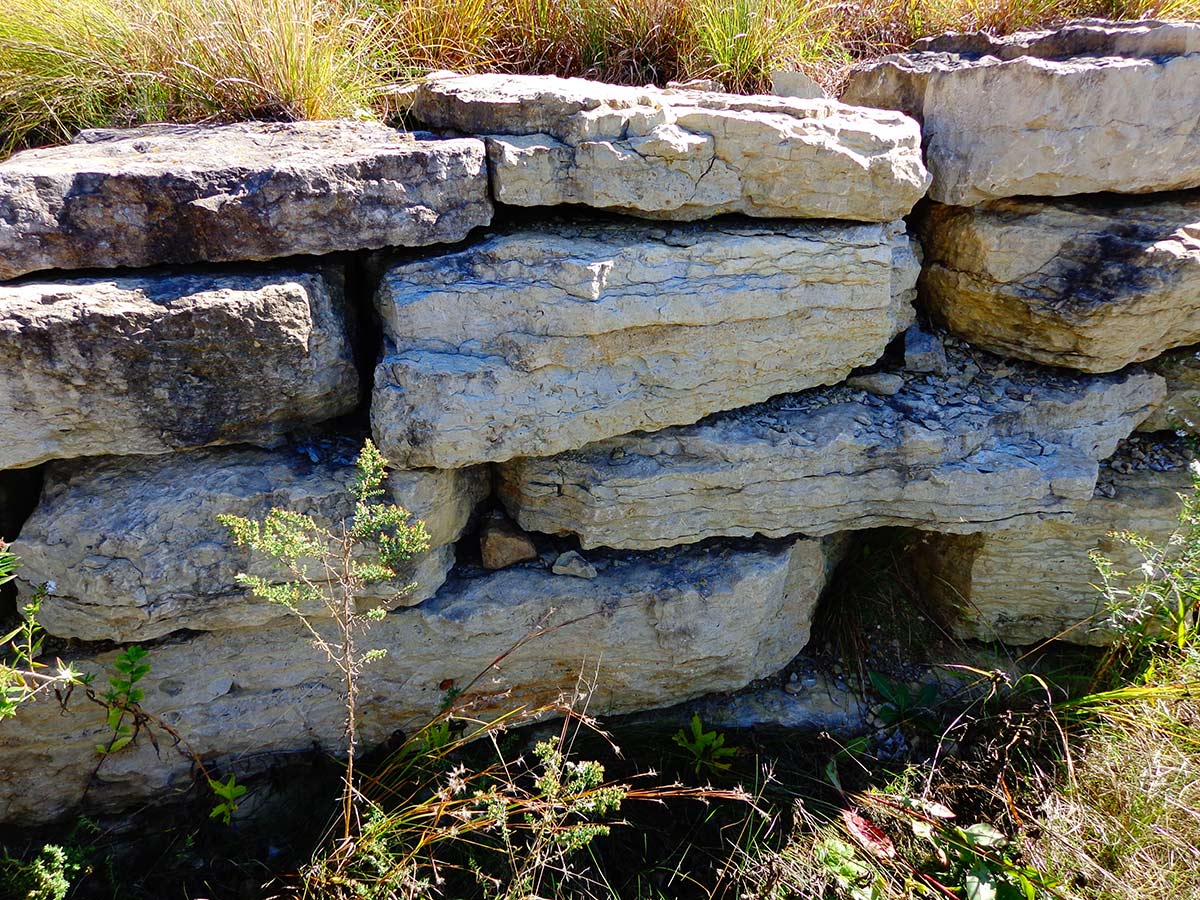What do our human ancestors have in common with the bugs in our backyards? For one thing, they both appreciate the value of a rocky outcropping as a habitat! Just as ancient humans (or a modern-day hiker caught in the rain) gathered together by caves and cliff ledges for shelter from the weather, many bugs rely on rock piles and stone walls as a key part of their habitat. By providing these habitat features in our yards and gardens, we can support a more diverse bug community, and get to see them perform some fascinating behaviors, too!
Rock features provide bugs with vital shelter
Just like us, many bugs like a sturdy roof over their heads! Leafcutter bees (Megachile spp.) make nests in the cracks or crevices present in some types of rock. Other tunnel-nesting bees, such as some digger bees (Anthophora spp.), use water to soften sandstone and excavate into it. Bumble bees (Bombus spp.) make homes in protected cavities inside rock piles and walls, while ground beetles (family Carabidae) and numerous other beneficial insects make their homes in gaps or burrows dug out from the soil under a stone.

Why do rocks, well, rock so much as shelter? Rocks are thick and sturdy, so they keep conditions beneath them relatively stable, even during more extreme weather. At high noon on a dry day, the space beneath a rock pile is shaded, cool, and damp. During a rainstorm, bugs huddling in the gaps in a stone wall are likely to stay safe and dry.
Even on normal days, rocks give invertebrates a useful way to control their body temperature. We humans can stay at more or less the same temperature all the time, but bugs cool down and heat up depending on their environment. Rocks hold on to heat particularly well, so a stone that's been in sunlight all day will stay warm for quite a while after the sun has fallen low in the sky. I often spot some of my favorite jumping spiders seeking out warm rocks in the late afternoon or early evening.
Because they are unlikely to move or break down, many bugs prefer rocks for long-term shelter, too. For example, many types of beneficial beetles, like rove beetles, ladybug beetles, and firefly beetles, like to use cracks and crevices under rocks to stay safe over the winter. Bugs that build their own structures to live in and/or raise their offspring, like mud dauber wasps and some spiders–both excellent at natural pest control–love to use rocks as an anchor.

How to build a rocky area for wildlife
There are many ways to incorporate rocky habitats, so it's easy to pick one that works for you and your space. The most straightforward is to set aside a small space for a rock pile. Include a diversity of rock types and sizes, and assemble with a "messy" configuration. This helps ensure that there are air spaces in the pile, and that access to ground is available under some parts of the pile. There’s nothing wrong with building the pile directly on top of the ground, but you can enhance the habitat by digging a shallow hole or depression and placing your largests rocks there first. This will create a more sturdy foundation, and a miniature cellar or cave-like space perfect for overwintering.

If a rock pile doesn’t work for your space, consider incorporating a stone wall where you need one anyway, such as a retaining wall or supporting raised flower beds. Depending on the terrain, you can also turn a small slope into a rocky embankment. You can choose the style of the stones to compliment your yard’s design, but be sure to use a “dry” construction method instead of filling gaps with mortar. Without crevices and gaps between the stones, stone walls are far less useful to wildlife.
If space allows, try including some rocky features in a handful of areas, to maximize the wildlife you can support. For example, you could build one in an area that often gets sun, and another in a corner that is usually shaded to give animals more options depending on their needs. You can boost the quality of the habitats by incorporating native grasses and wildflowers nearby, so the bugs living in rocks have easy access to food and nesting materials!

Watching wildlife on the rocks
As you begin to notice the animals using your new rock feature, you may be surprised at how popular it is. Here is just some of what you might see:
- Mining, leafcutter, and bumble bees excavating their nests! Look out for little heaps of soil at the base of a rock. You can wait by a nest entrance to spot the bee entering or leaving (and maybe snag a photo!)
- Ground beetles and other night-time bugs! Check your rock piles at pre-dawn or dusk to meet the bugs that sleep during the day. Bring a flashlight or headlamp to get a good look; some species are shiny or colorful.
- Jumping spiders putting on a song and dance show! Male jumping spiders sometimes use sunlit rocks as a stage for their elaborate courtship display. Be sure to move slowly so you don’t disrupt the performance!

Before you know it, your rock pile and stone wall might end up as your go-to spot to see cool bugs in your yard!
Resources and further reading:
- Tiny Places for Tiny Animals: Building the Microhabitats that Bugs Need to Thrive
- Nesting & Overwintering Habitat for Pollinators & Other Beneficial Insects
- Habitat Planning for Beneficial Insects




